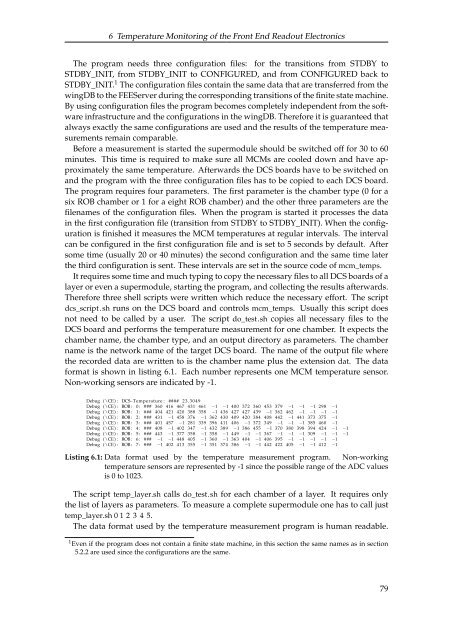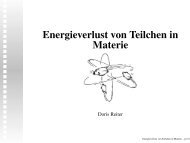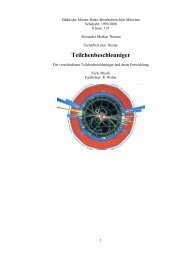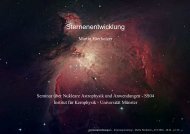The FEE Server Control Engine of the ALICE-TRD - Westfälische ...
The FEE Server Control Engine of the ALICE-TRD - Westfälische ...
The FEE Server Control Engine of the ALICE-TRD - Westfälische ...
You also want an ePaper? Increase the reach of your titles
YUMPU automatically turns print PDFs into web optimized ePapers that Google loves.
6 Temperature Monitoring <strong>of</strong> <strong>the</strong> Front End Readout Electronics<br />
<strong>The</strong> program needs three configuration files: for <strong>the</strong> transitions from STDBY to<br />
STDBY_INIT, from STDBY_INIT to CONFIGURED, and from CONFIGURED back to<br />
STDBY_INIT. 1 <strong>The</strong> configuration files contain <strong>the</strong> same data that are transferred from <strong>the</strong><br />
wingDB to <strong>the</strong> <strong>FEE</strong><strong>Server</strong> during <strong>the</strong> corresponding transitions <strong>of</strong> <strong>the</strong> finite state machine.<br />
By using configuration files <strong>the</strong> program becomes completely independent from <strong>the</strong> s<strong>of</strong>tware<br />
infrastructure and <strong>the</strong> configurations in <strong>the</strong> wingDB. <strong>The</strong>refore it is guaranteed that<br />
always exactly <strong>the</strong> same configurations are used and <strong>the</strong> results <strong>of</strong> <strong>the</strong> temperature measurements<br />
remain comparable.<br />
Before a measurement is started <strong>the</strong> supermodule should be switched <strong>of</strong>f for 30 to 60<br />
minutes. This time is required to make sure all MCMs are cooled down and have approximately<br />
<strong>the</strong> same temperature. Afterwards <strong>the</strong> DCS boards have to be switched on<br />
and <strong>the</strong> program with <strong>the</strong> three configuration files has to be copied to each DCS board.<br />
<strong>The</strong> program requires four parameters. <strong>The</strong> first parameter is <strong>the</strong> chamber type (0 for a<br />
six ROB chamber or 1 for a eight ROB chamber) and <strong>the</strong> o<strong>the</strong>r three parameters are <strong>the</strong><br />
filenames <strong>of</strong> <strong>the</strong> configuration files. When <strong>the</strong> program is started it processes <strong>the</strong> data<br />
in <strong>the</strong> first configuration file (transition from STDBY to STDBY_INIT). When <strong>the</strong> configuration<br />
is finished it measures <strong>the</strong> MCM temperatures at regular intervals. <strong>The</strong> interval<br />
can be configured in <strong>the</strong> first configuration file and is set to 5 seconds by default. After<br />
some time (usually 20 or 40 minutes) <strong>the</strong> second configuration and <strong>the</strong> same time later<br />
<strong>the</strong> third configuration is sent. <strong>The</strong>se intervals are set in <strong>the</strong> source code <strong>of</strong> mcm_temps.<br />
It requires some time and much typing to copy <strong>the</strong> necessary files to all DCS boards <strong>of</strong> a<br />
layer or even a supermodule, starting <strong>the</strong> program, and collecting <strong>the</strong> results afterwards.<br />
<strong>The</strong>refore three shell scripts were written which reduce <strong>the</strong> necessary effort. <strong>The</strong> script<br />
dcs_script.sh runs on <strong>the</strong> DCS board and controls mcm_temps. Usually this script does<br />
not need to be called by a user. <strong>The</strong> script do_test.sh copies all necessary files to <strong>the</strong><br />
DCS board and performs <strong>the</strong> temperature measurement for one chamber. It expects <strong>the</strong><br />
chamber name, <strong>the</strong> chamber type, and an output directory as parameters. <strong>The</strong> chamber<br />
name is <strong>the</strong> network name <strong>of</strong> <strong>the</strong> target DCS board. <strong>The</strong> name <strong>of</strong> <strong>the</strong> output file where<br />
<strong>the</strong> recorded data are written to is <strong>the</strong> chamber name plus <strong>the</strong> extension dat. <strong>The</strong> data<br />
format is shown in listing 6.1. Each number represents one MCM temperature sensor.<br />
Non-working sensors are indicated by -1.<br />
Debug (\CE) : DCS−Temperature : #### 23.3049<br />
Debug (\CE) : ROB: 0 : ### 360 416 467 431 461 −1 −1 400 372 360 453 379 −1 −1 −1 298 −1<br />
Debug (\CE) : ROB: 1 : ### 404 421 420 388 358 −1 436 427 427 439 −1 362 462 −1 −1 −1 −1<br />
Debug (\CE) : ROB: 2 : ### 431 −1 458 376 −1 362 430 409 420 384 408 442 −1 441 373 375 −1<br />
Debug (\CE) : ROB: 3 : ### 401 457 −1 281 339 396 411 406 −1 372 349 −1 −1 −1 385 460 −1<br />
Debug (\CE) : ROB: 4 : ### 408 −1 402 347 −1 432 389 −1 386 455 −1 370 380 398 394 424 −1 −1<br />
Debug (\CE) : ROB: 5 : ### 443 −1 377 358 −1 358 −1 449 −1 −1 367 −1 −1 −1 309 −1 −1 −1<br />
Debug (\CE) : ROB: 6 : ### −1 −1 448 405 −1 360 −1 363 404 −1 406 395 −1 −1 −1 −1 −1<br />
Debug (\CE) : ROB: 7 : ### −1 402 413 355 −1 351 374 386 −1 −1 442 422 405 −1 −1 412 −1<br />
Listing 6.1: Data format used by <strong>the</strong> temperature measurement program. Non-working<br />
temperature sensors are represented by -1 since <strong>the</strong> possible range <strong>of</strong> <strong>the</strong> ADC values<br />
is 0 to 1023.<br />
<strong>The</strong> script temp_layer.sh calls do_test.sh for each chamber <strong>of</strong> a layer. It requires only<br />
<strong>the</strong> list <strong>of</strong> layers as parameters. To measure a complete supermodule one has to call just<br />
temp_layer.sh 0 1 2 3 4 5.<br />
<strong>The</strong> data format used by <strong>the</strong> temperature measurement program is human readable.<br />
1 Even if <strong>the</strong> program does not contain a finite state machine, in this section <strong>the</strong> same names as in section<br />
5.2.2 are used since <strong>the</strong> configurations are <strong>the</strong> same.<br />
79







